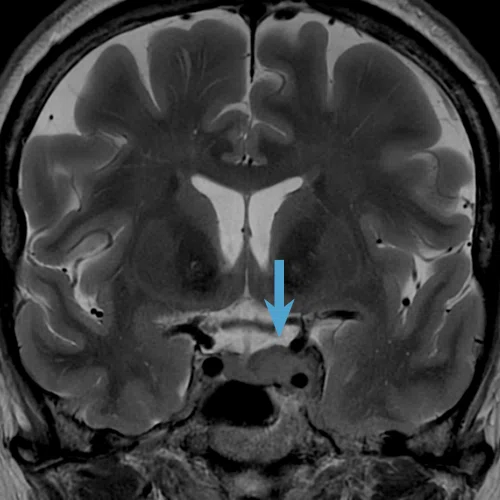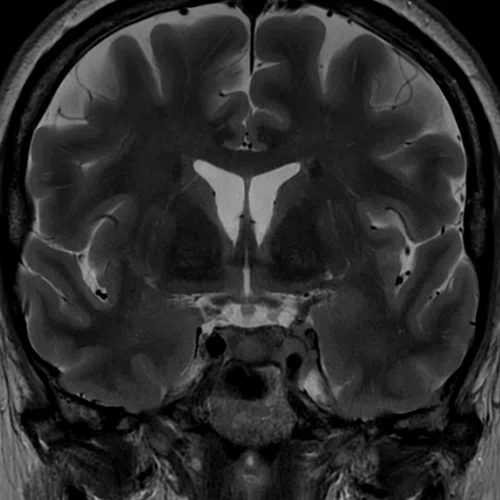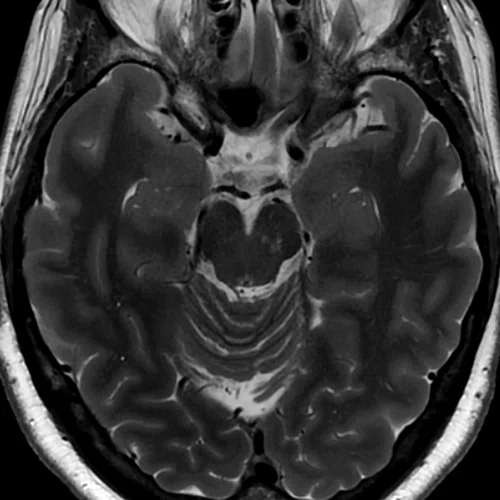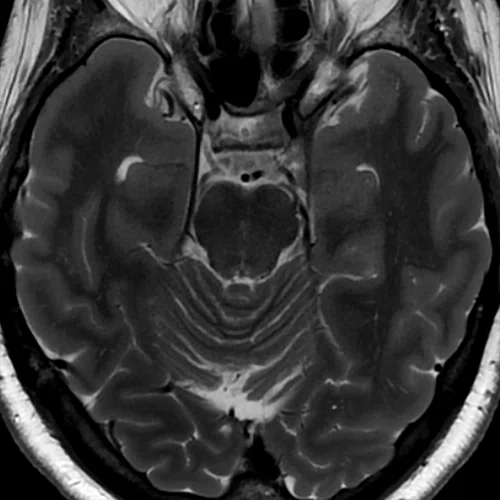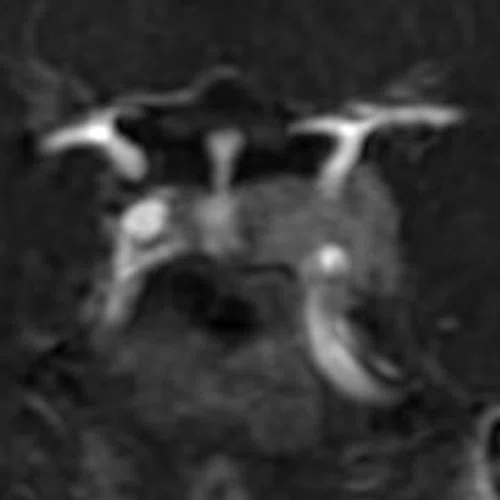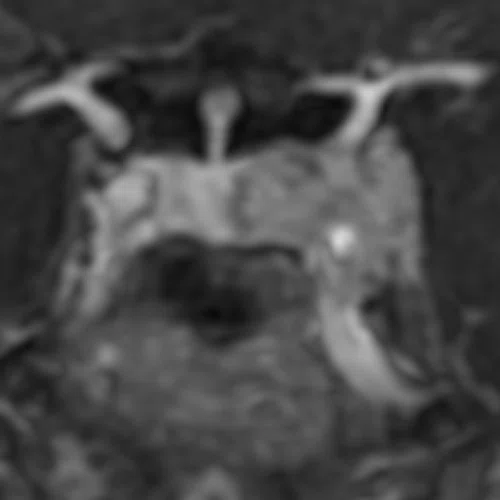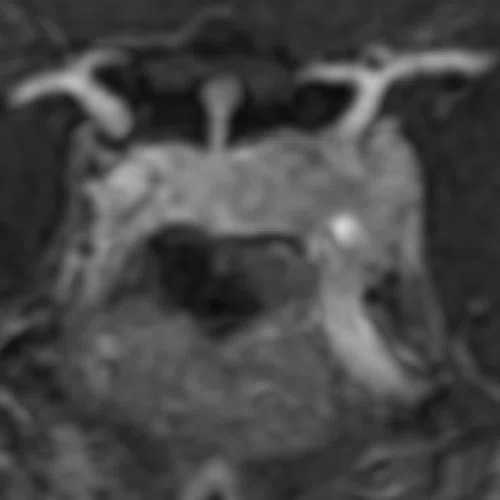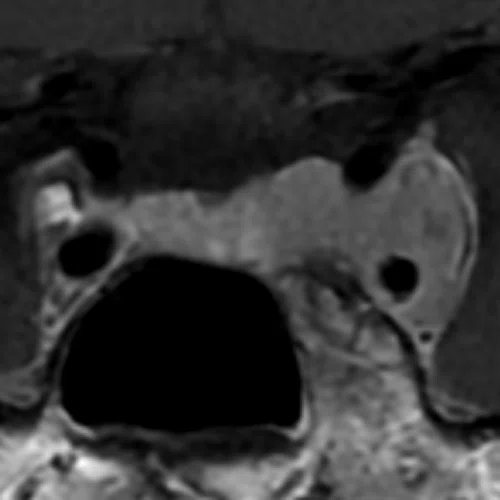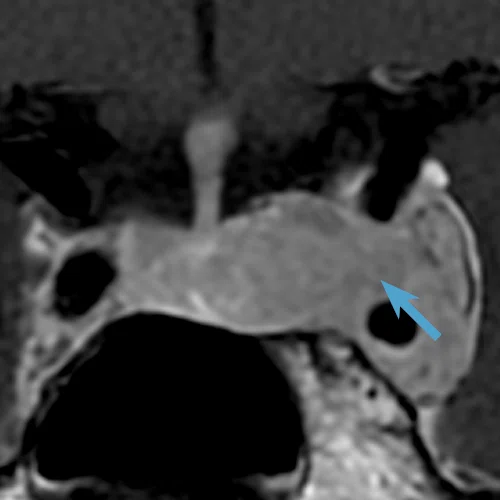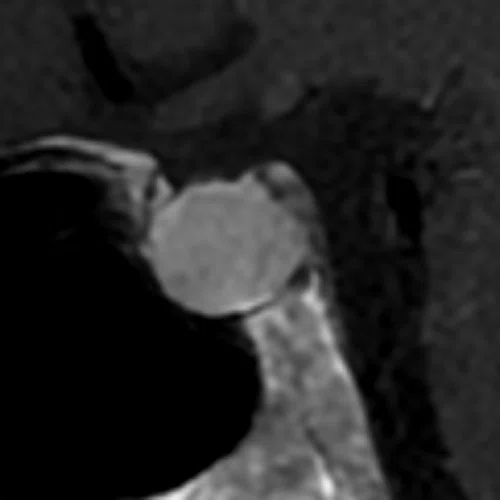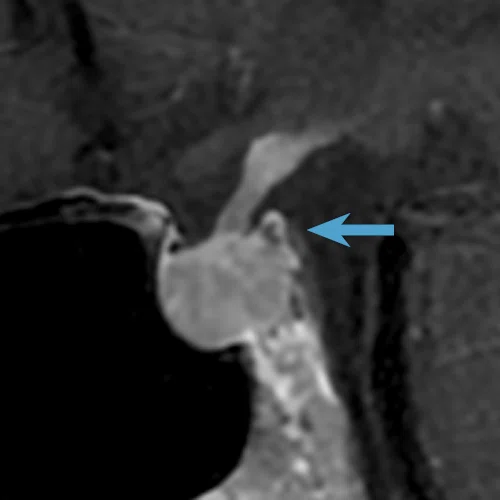A
Figure 1.
A 48-year-old patient referred for an MR of the pituitary. AIR™ Recon DL Medium and the 48-ch Head Coil were used. (A, B) Coronal T2 PROPELLER, 0.3 x 0.3 x 3 mm, 3:09 min. and (C, D) Axial T2 PROPELLER, 0.3 x 0.3 x 3 mm, 3:03 min.
B
Figure 1.
A 48-year-old patient referred for an MR of the pituitary. AIR™ Recon DL Medium and the 48-ch Head Coil were used. (A, B) Coronal T2 PROPELLER, 0.3 x 0.3 x 3 mm, 3:09 min. and (C, D) Axial T2 PROPELLER, 0.3 x 0.3 x 3 mm, 3:03 min.
C
Figure 1.
A 48-year-old patient referred for an MR of the pituitary. AIR™ Recon DL Medium and the 48-ch Head Coil were used. (A, B) Coronal T2 PROPELLER, 0.3 x 0.3 x 3 mm, 3:09 min. and (C, D) Axial T2 PROPELLER, 0.3 x 0.3 x 3 mm, 3:03 min.
D
Figure 1.
A 48-year-old patient referred for an MR of the pituitary. AIR™ Recon DL Medium and the 48-ch Head Coil were used. (A, B) Coronal T2 PROPELLER, 0.3 x 0.3 x 3 mm, 3:09 min. and (C, D) Axial T2 PROPELLER, 0.3 x 0.3 x 3 mm, 3:03 min.
A
Figure 2.
Same patient as Figure 1. AIR™ Recon DL High and the 48-ch Head Coil were used. (A-D) 3D FSPGR, 0.9 x 0.9 x 0.9 mm, 0:25 min./phase, (A) mask, (B) phase 1, (C) phase 2 and (D) phase 3; (E, F) Coronal T1 FSE, 0.4 x 0.4 x 2.0 mm, 3:24 min.; and (G, H) sagittal T1 FSE, 0.4 x 0.4 x 2.0 mm, 3:25 min.
B
Figure 2.
Same patient as Figure 1. AIR™ Recon DL High and the 48-ch Head Coil were used. (A-D) 3D FSPGR, 0.9 x 0.9 x 0.9 mm, 0:25 min./phase, (A) mask, (B) phase 1, (C) phase 2 and (D) phase 3; (E, F) Coronal T1 FSE, 0.4 x 0.4 x 2.0 mm, 3:24 min.; and (G, H) sagittal T1 FSE, 0.4 x 0.4 x 2.0 mm, 3:25 min.
C
Figure 2.
Same patient as Figure 1. AIR™ Recon DL High and the 48-ch Head Coil were used. (A-D) 3D FSPGR, 0.9 x 0.9 x 0.9 mm, 0:25 min./phase, (A) mask, (B) phase 1, (C) phase 2 and (D) phase 3; (E, F) Coronal T1 FSE, 0.4 x 0.4 x 2.0 mm, 3:24 min.; and (G, H) sagittal T1 FSE, 0.4 x 0.4 x 2.0 mm, 3:25 min.
D
Figure 2.
Same patient as Figure 1. AIR™ Recon DL High and the 48-ch Head Coil were used. (A-D) 3D FSPGR, 0.9 x 0.9 x 0.9 mm, 0:25 min./phase, (A) mask, (B) phase 1, (C) phase 2 and (D) phase 3; (E, F) Coronal T1 FSE, 0.4 x 0.4 x 2.0 mm, 3:24 min.; and (G, H) sagittal T1 FSE, 0.4 x 0.4 x 2.0 mm, 3:25 min.
E
Figure 2.
Same patient as Figure 1. AIR™ Recon DL High and the 48-ch Head Coil were used. (A-D) 3D FSPGR, 0.9 x 0.9 x 0.9 mm, 0:25 min./phase, (A) mask, (B) phase 1, (C) phase 2 and (D) phase 3; (E, F) Coronal T1 FSE, 0.4 x 0.4 x 2.0 mm, 3:24 min.; and (G, H) sagittal T1 FSE, 0.4 x 0.4 x 2.0 mm, 3:25 min.
F
Figure 2.
Same patient as Figure 1. AIR™ Recon DL High and the 48-ch Head Coil were used. (A-D) 3D FSPGR, 0.9 x 0.9 x 0.9 mm, 0:25 min./phase, (A) mask, (B) phase 1, (C) phase 2 and (D) phase 3; (E, F) Coronal T1 FSE, 0.4 x 0.4 x 2.0 mm, 3:24 min.; and (G, H) sagittal T1 FSE, 0.4 x 0.4 x 2.0 mm, 3:25 min.
G
Figure 2.
Same patient as Figure 1. AIR™ Recon DL High and the 48-ch Head Coil were used. (A-D) 3D FSPGR, 0.9 x 0.9 x 0.9 mm, 0:25 min./phase, (A) mask, (B) phase 1, (C) phase 2 and (D) phase 3; (E, F) Coronal T1 FSE, 0.4 x 0.4 x 2.0 mm, 3:24 min.; and (G, H) sagittal T1 FSE, 0.4 x 0.4 x 2.0 mm, 3:25 min.
H
Figure 2.
Same patient as Figure 1. AIR™ Recon DL High and the 48-ch Head Coil were used. (A-D) 3D FSPGR, 0.9 x 0.9 x 0.9 mm, 0:25 min./phase, (A) mask, (B) phase 1, (C) phase 2 and (D) phase 3; (E, F) Coronal T1 FSE, 0.4 x 0.4 x 2.0 mm, 3:24 min.; and (G, H) sagittal T1 FSE, 0.4 x 0.4 x 2.0 mm, 3:25 min.
result


PREVIOUS
${prev-page}
NEXT
${next-page}
Subscribe Now
Manage Subscription
FOLLOW US
Contact Us • Cookie Preferences • Privacy Policy • California Privacy PolicyDo Not Sell or Share My Personal Information • Terms & Conditions • Security
© 2024 GE HealthCare. GE is a trademark of General Electric Company. Used under trademark license.
Case Studies
High spatial resolution imaging for the depiction of microadenoma in the pituitary gland
High spatial resolution imaging for the depiction of microadenoma in the pituitary gland
By Mar Jiménez de la Peña, MD, Associate Head of Diagnostic Imaging, and Vincente Martínez de Vega, MD, Head of the Division of Radiology, Quirónsalud Madrid University Hospital, Madrid, Spain
Lesions in the pituitary gland are usually small in size, therefore, high spatial resolution is required to detect microlesions and more accurately define lesion margins, which is crucial for surgical planning. Further, temporal resolution is required to resolve any variance of the enhancement curves between healthy tissue and lesions.
Patient history
A 48-year-old patient with typical height and weight with a history of autoimmune hypothyroidism due to Hashimoto’s disease. Elevated prolactin levels were detected in a routine endocrinology follow-up exam and patient complained of headaches.
Results
Enlargement of the adenohypophysis and the pituitary stalk were observed, not consistent with the patient’s age, with avid and heterogeneous intravenous contrast enhancement, suggestive of autoimmune hypophysitis. Slight bulging of the right paramedial sellar diaphragm due to a millimetric hypoenhancing lesion suggests a pituitary microadenoma. Laboratory results confirmed increasing hyperprolactinemia and hypothyroidism.
Figure 2.
Same patient as Figure 1. AIR™ Recon DL High and the 48-ch Head Coil were used. (A-D) 3D FSPGR, 0.9 x 0.9 x 0.9 mm, 0:25 min./phase, (A) mask, (B) phase 1, (C) phase 2 and (D) phase 3; (E, F) Coronal T1 FSE, 0.4 x 0.4 x 2.0 mm, 3:24 min.; and (G, H) sagittal T1 FSE, 0.4 x 0.4 x 2.0 mm, 3:25 min.
Discussion
AIR™ Recon DL allowed consistent acquisition of optimal resolution for diagnosis of even the smallest lesions, thanks to its compatibility with most sequences, providing solutions for both cooperative and non-cooperative patients.
In this case, the use of AIR™ Recon DL allowed for the identification of a dual pathology: autoimmune hypophysitis and a 3 mm microadenoma, which could go unnoticed if not for the excellent image quality and spatial resolution. The information obtained from the MR exam was particularly relevant for the endocrine management of the patient, as the dual pathology, which was not suspected in the patient, was identified.
Further, the 48-channel Head Coil allowed us to obtain high-resolution imaging of the pituitary gland. The use of artificial intelligence for slice prescription with AIR x™ ensures a good and reproducible longitudinal study, and AIR™ Recon DL provides incredible image quality.
AIR™ Recon DL is applicable to many types of MR examinations, significantly improving spatial and temporal resolution, and facilitating the early detection of very small lesions before symptoms become evident or lesions grow to a point where they are no longer operable or conservatively treatable. We can also achieve a reduction in the total study duration, despite the increase in image quality. AIR™ Recon DL is excellent in terms of enhancing image quality and can aid the physician in making an early and accurate diagnosis.
DOWNLOAD ARTICLE HERE










